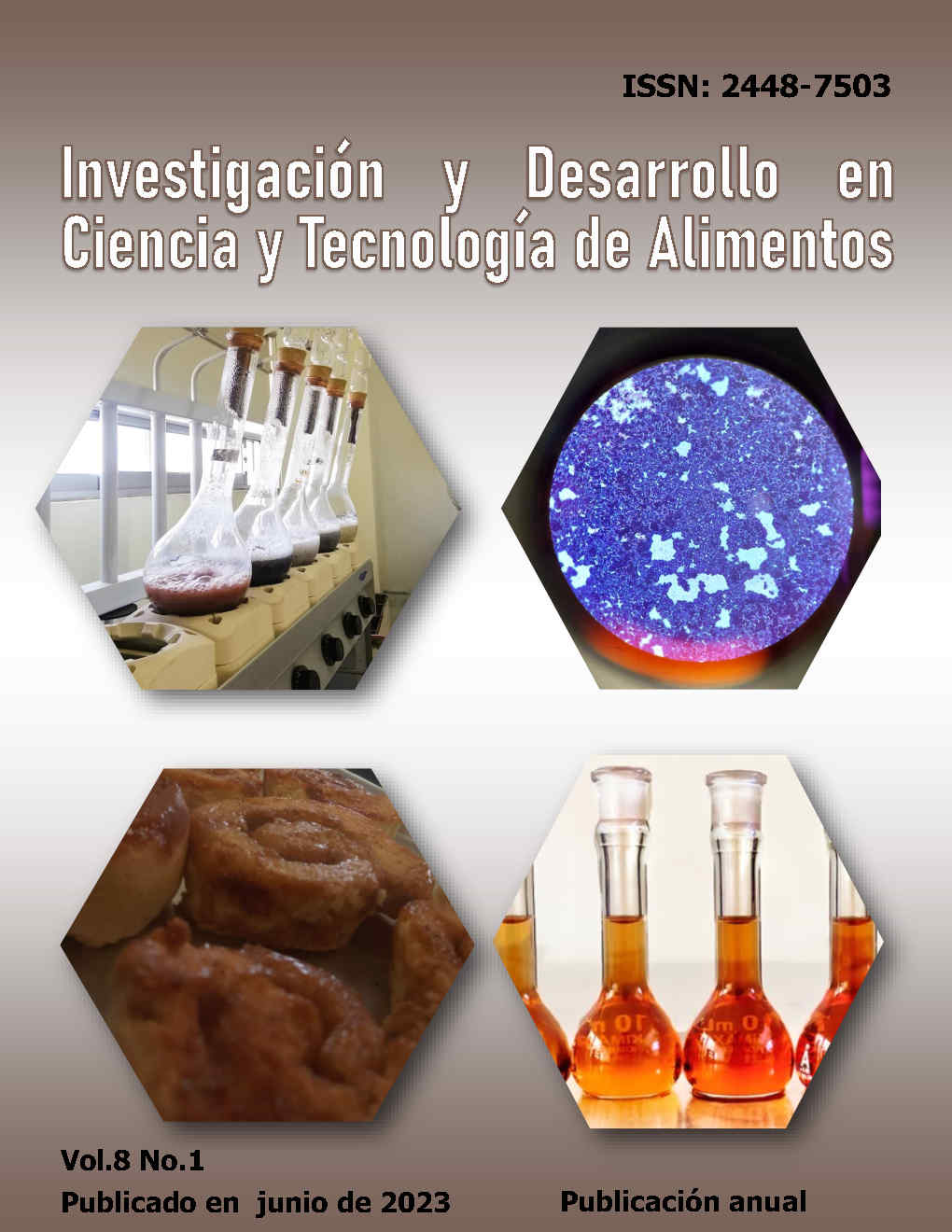Caracterización fisicoquímica, polifenoles totales y capacidad antioxidante en tres variedades de guayaba de la región de Santiago el Chique, Zacatecas
DOI:
https://doi.org/10.29105/idcyta.v8i1.28Keywords:
Psidium guajava L, antioxidants, polyphenols, vitamin “C”Abstract
Guava (Psidium guajava L.) is a tropical fruit belonging to the Myrtaceae family, consumed fresh and processed, highly appreciated for its nutritional value and also due to the presence of secondary plant metabolites with antioxidant activity, beneficial for human health, called phytochemicals. The state of Zacatecas is the third largest producer of guava in México. In the south of the state, the region of Santiago el Chique contributes to this production. The aim of the present work was to determine some physicochemical parameters, the total polyphenol content and the antioxidant capacity of three guava varieties (Blanca, China and Pink). The results showed statistically significant differences in practically all the parameters analysed, except in the case of % moisture. Ascorbic acid concentration stood out in the "pink" guava, compared to the other varieties.
Downloads
References
Aguilar Karla, A. Garvín, A. Ibarz, P. E.D. Augusto (2017). Ascorbic acid stability in fruit juices during thermosonication. Ultrasonics Sonochemistry 37: 375-381. DOI: https://doi.org/10.1016/j.ultsonch.2017.01.029
Ariza, M. T., Reboredo-Rodríguez, P., Cervantes, L., Soria, C., Martínez-Ferri, E., González-Barreiro, C., Cancho-Grande, B., Battino, M., & Simal-Gándara, J. (2018). Bioaccessibility and potential bioavailability of phenolic compounds from achenes as a new target for strawberry breeding programs. Food Chemistry, 248, 155–165. https://doi.org/10.1016/j.foodchem.2017.11.105. DOI: https://doi.org/10.1016/j.foodchem.2017.11.105
Brand-Williams W, Cuvelier ME, Berset C. (1995). Use of free radical method to evaluate antioxidant activity. LWT - Food Science and Technology. 28: 25–30. http://dx.doi.org/10.1016/S0023-6438(95)80008-5. DOI: https://doi.org/10.1016/S0023-6438(95)80008-5
Cervantes, L., Martínez-Ferria E., Soria C., Ariza M. T. (2020). Bioavailability of phenolic compounds in strawberry, raspberry and blueberry: Insights for breeding programs. Food Bioscience 37, 100680 DOI: https://doi.org/10.1016/j.fbio.2020.100680
Comert E.D., B.A. Mogol, V. Gokmen (2020). Relationship between color and antioxidant capacity of fruits and vegetables. Current Research in Food Science 2: 1–10 DOI: https://doi.org/10.1016/j.crfs.2019.11.001
Fajardo-Ortíz A. G., Legaria-Solano J. P., Granados-Moreno J. E., Martínez-Solís J., Celis-Forero A. (2019). Caracterización morfológica y bioquímica de tipos de guayaba (psidium guajava L.) colectados en Sumapaz, Colombia. Rev. Fitotec. Mex. Vol. 42 (3): 289 - 299 DOI: https://doi.org/10.35196/rfm.2019.3.289-299
Li, BB, Smith B, Hossain M. (2006). Extraction of phenolics from citrus peels: II. Enzyme-assisted extraction method. Separation and Purification Technology. 48: 189-196. https://doi.org/10.1016/j.foodchem.2016.10.137 DOI: https://doi.org/10.1016/j.seppur.2005.07.019
Li, K., Ma, C., Jian, T., Sun, H., Wang, L., Xu, H., Li, W., Su, H., & Cheng, X. (2017). Making good use of the byproducts of cultivation: Green synthesis and antibacterial effects of silver nanoparticles using the leaf extract of blueberry. Journal of Food Science & Technology, 54(11), 3569–3576. https://doi.org/10.1007/s13197-017-2815-1. DOI: https://doi.org/10.1007/s13197-017-2815-1
Patel P., Sunkara R., Walker L. T, Verghese M. (2016). Effect of Drying Techniques on Antioxidant Capacity of Guava Fruit. Food and Nutrition Sciences. 7: 544-554. http://dx.doi.org/10.4236/fns.2016.77056 DOI: https://doi.org/10.4236/fns.2016.77056
Re R, Pellegrini N, Proteggente A, Pannala A, Yang M, Rice-Evans C. (1999). Antioxidant activity applying an improved ABTS radical cation decolorization assay. Free Radical Biology and Medicine. 26: 1231–1237. https://doi.org/10.1016/S0891-5849(98)00315-3 DOI: https://doi.org/10.1016/S0891-5849(98)00315-3
Rojas-Barquera D. & Narváez-Cuenca C.E. (2009). Determinación de vitamina c, compuestos fenólicos totales y actividad antioxidante de frutas de guayaba (Psidium guajava L.) cultivadas en Colombia. Quim. Nova, Vol. 32, No. 9, 2336-2340 DOI: https://doi.org/10.1590/S0100-40422009000900019
Saura-Calixto, F. and Goñi, I. (2006) Antioxidant Capacity of the Spanish Mediterranean Diet. Food Chemistry, 94, 442-447. http://dx.doi.org/10.1016/j.foodchem.2004.11.033 DOI: https://doi.org/10.1016/j.foodchem.2004.11.033
Servicio de Información Agroalimentaria y Pesquera (SIAP) (2022). Producción anual agrícola. Recuperado de: https://www.gob.mx/siap/acciones-y-programas/produccion-agricola-33119
Tomás-Barberán F, Gil M, Cremin P, Waterhouse A, Hess-Pierce B, Kader A. (2001). HPLC-DAD-ESIMS analysis of phenolic compounds in nectarines, peaches, and plums. Journal of Agricultural and Food Chemistry. 49: 4748-4760. https://doi.org/10.1021/jf0104681 DOI: https://doi.org/10.1021/jf0104681
Vargas-Madriz H., Barrientos-Martínez A., Cruz-Alvarez O., Martínez-Damián M. T., Talavera-Villareal A. (2018). Physicochemical quality parameters in guava fruit with presence of larvae of Conotrachelus dimidiatus (Champion) (Coleoptera: Curculionidae) DOI: https://doi.org/10.5154/r.rchsh.2018.10.019
Downloads
Published
How to Cite
Issue
Section
License
Copyright (c) 2023 A. Ávila-Palma, C.S. Contreras-Martínez, R. Gutiérrez-Hernández, L.G. Ramos-Muñoz, J.M. García-González, J. Carranza-Téllez, J. Carranza-Concha

This work is licensed under a Creative Commons Attribution 4.0 International License.
Los autores/as que publiquen en esta revista aceptan las siguientes condiciones:
a. Los autores/as conservarán sus derechos de autor y garantizarán a la revista el derecho de primera publicación de su obra, el cual estará simultáneamente sujeto a la Licencia Creative Commons Atribución 4.0 Internacional. que permite a terceros compartir la obra siempre que se indique su autor y su primera publicación esta revista.
b. Los autores/as pueden realizar otros acuerdos contractuales independientes y adicionales para la distribución no exclusiva de la versión del artículo publicado en esta revista (p. ej., incluirlo en un repositorio institucional o publicarlo en un libro) siempre que indiquen claramente que el trabajo se publicó por primera vez en esta revista.
c. Se permite y recomienda a los autores/as a publicar su trabajo en Internet (por ejemplo en páginas institucionales o personales) posterior al proceso de revisión y publicación, ya que puede conducir a intercambios productivos y a una mayor y más rápida difusión del trabajo publicado.





